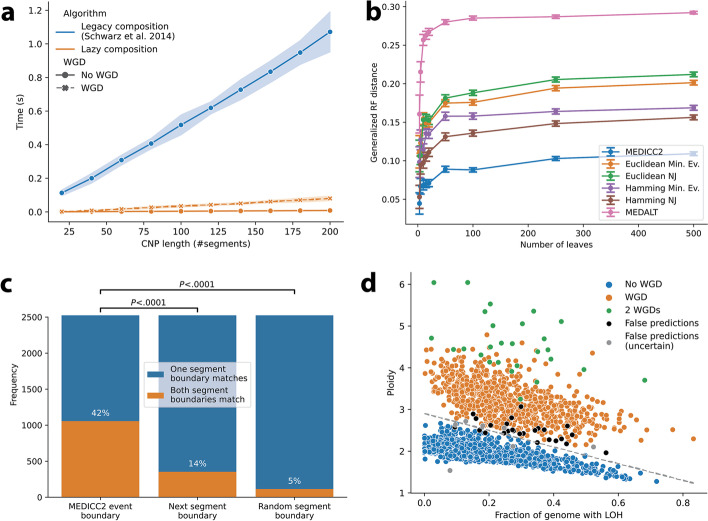Fig. 2.
Algorithm performance and validation. a Runtime of different composition strategies. Copy-number profiles were simulated with increasing lengths from 20 to 200 segments. Computation time of the MEDs is linear with respect to the length of the input sequences. While MED-WGD took significantly longer to compute than the MED without WGD, the new lazy composition strategy reduced runtime by orders of magnitude. Shaded areas correspond to standard errors. b Performance on simulated data: Using an independent simulation routine we benchmarked MEDICC2 against a range of other methods. The reconstructed trees were compared to the simulated trees using the generalized Robinson-Foulds distance. As expected, the GRF distance rises with increasing tree size. MEDICC2 outperforms all other methods for all tree sizes. c Validation of MEDICC2 events with SVs. Pairs of MEDICC2 events and SVs were chosen based on an overlap of the starting segment. We assume MEDICC2 events to be supported by the SV if the ends also overlap. Shown here are the results using only duplications and deletions with size larger than 10Mbp. d The MEDICC2 WGD score for 2778 cancer genomes. Individual cancers are plotted based on their average ploidy and fraction of genome with LOH. The original separating line between WGD and non-WGD tumors was estimated by Dentro et al. as y = 2.9 − 2x. Correct “WGD” and “no WGD” predictions from MEDICC2 were marked in orange and blue while false predictions were marked in black and gray (latter if the PCAWG WGD status was “uncertain”). Abbreviations: NJ: Neighbor joining, Min. Ev.: Minimum Evolution

